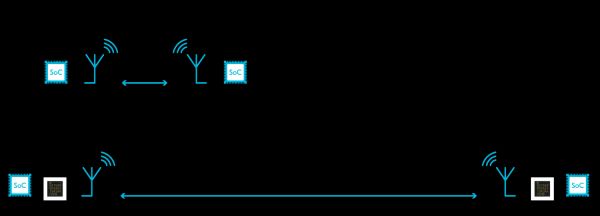使用范围扩展器提高链接预算
Nordic nRF52 和 nRF53 系列 SoC 的射程和链路稳健性可满足大多数应用和用例的要求,但有时添加射频前端模块 (FEM) 才是正确的选择。射频前端模块可增加两个无线设备的通信距离,同时还能增强链路的稳健性。将我们的 nRF21540 射频前端模块与 nRF52 或 nRF53 系列 SoC 相结合,可将射程提高 6.3-10 倍。

在上图中,一个 +8 dBm 发射机输出功率的普通连接与一个 +20 dBm 发射机输出功率的连接进行了比较,该连接的两端都安装了 nRF21540 射频 FEM。nRF21540 增加的 TX 输出功率和 RX 灵敏度都有助于提高连接范围。如果使用发射机输出功率小于 +8 dBm 的 Nordic SoC,则范围增加得更大。
请注意,并非所有地区都允许 +20 dBm 的发射机输出功率。有关详细信息,请参阅最大规范输出功率表。
最大限度地提高链接预算,同时不超出监管范围
发射机输出功率和接收机灵敏度都会直接影响连接的链路预算。
在蓝牙 5 规范将最大允许输出功率提高到 +20 dBm 之后,设备输出功率在大多数地区都受到了法规的限制。
将 nRF21540 射频 FEM 与 nRF52 或 nRF53 系列 SoC 配对,可实现细粒度的发射功率可调性,从而使发射功率最大可低于下面提到的法规限制 1 dBm。发射增益可动态调整,从而实现自适应增益控制算法。在运行 1 Mbps 蓝牙 LE 时,所有 nRF52 和 nRF53 系列 SoC 的 RX 灵敏度都提高到 -100 dBm。在运行蓝牙长距离、Thread 或 Zigbee 时,灵敏度会更高。
最大规范 TX 输出功率表
下表概括了以 dBm EIRP 为单位的主要监管输出功率限制。请检查您计划将产品运往的地区的规定。美国的无线通信由 FCC 监管,欧洲由 ETSI 监管,日本由 ARIB 监管。
|
ORGANIZATION
|
BLUETOOTH LE
|
BLUETOOTH LE
|
BLUETOOTH LE
|
BLUETOOTH LE
|
802.15.4
|
|
Throughput
|
125 kbps
|
500 kbps
|
1 Mbps
|
2 Mbps
|
250 kbps
|
|
FCC (USA) *
|
14
|
14
|
20
|
20
|
30
|
|
ETSI (Europe)
|
10
|
10
|
10
|
10
|
13**
|
|
ARIB (Japan)
|
10
|
10
|
10
|
10
|
10
|
|
China
|
10
|
10
|
10
|
10
|
10
|
|
Korea
|
10
|
10
|
10
|
10
|
10
|
- FCC 的最大输出功率为 +30 dBm,但蓝牙技术联盟(Bluetooth SIG)将其限制为 +20 dBm。对于 125 kbps 和 500 kbps,功率谱密度法规将输出功率限制在 14 dBm。802.15.4 只受 FCC 规定的限制。
- ETSI 对 802.15.4 的限制为 10 dBm/1 MHz。虽然 802.15.4 规定的信道宽度为 5 MHz,但占用的带宽仅占信道的 2 MHz。将带宽增加一倍至 2 MHz 会增加 3 dB,从而达到 13 dBm。
链路稳健性
提高链路稳定性
除了增加传输距离,射频 FEM 还能提高链路连接的稳健性。更稳健的链路可减少数据包丢失,也就是减少重传。重传是冗余数据包,会降低能效和最大吞吐量。成功接收第一个数据包的概率也会增加,从而使链路延迟更加稳定。
应用
使用射频 FEM 启用和/或优化您的应用
许多应用都可以从添加射频 FEM 中受益,包括资产跟踪、智能家居、工业、智能农业、音频以及专业照明。智能家居和工业应用可从扩展范围(如整个家庭的范围)中获益。音频应用则受益于吞吐量的增加和延迟的减少。下图显示了在有和没有增程器的情况下,工厂内被跟踪资产的通信范围。
